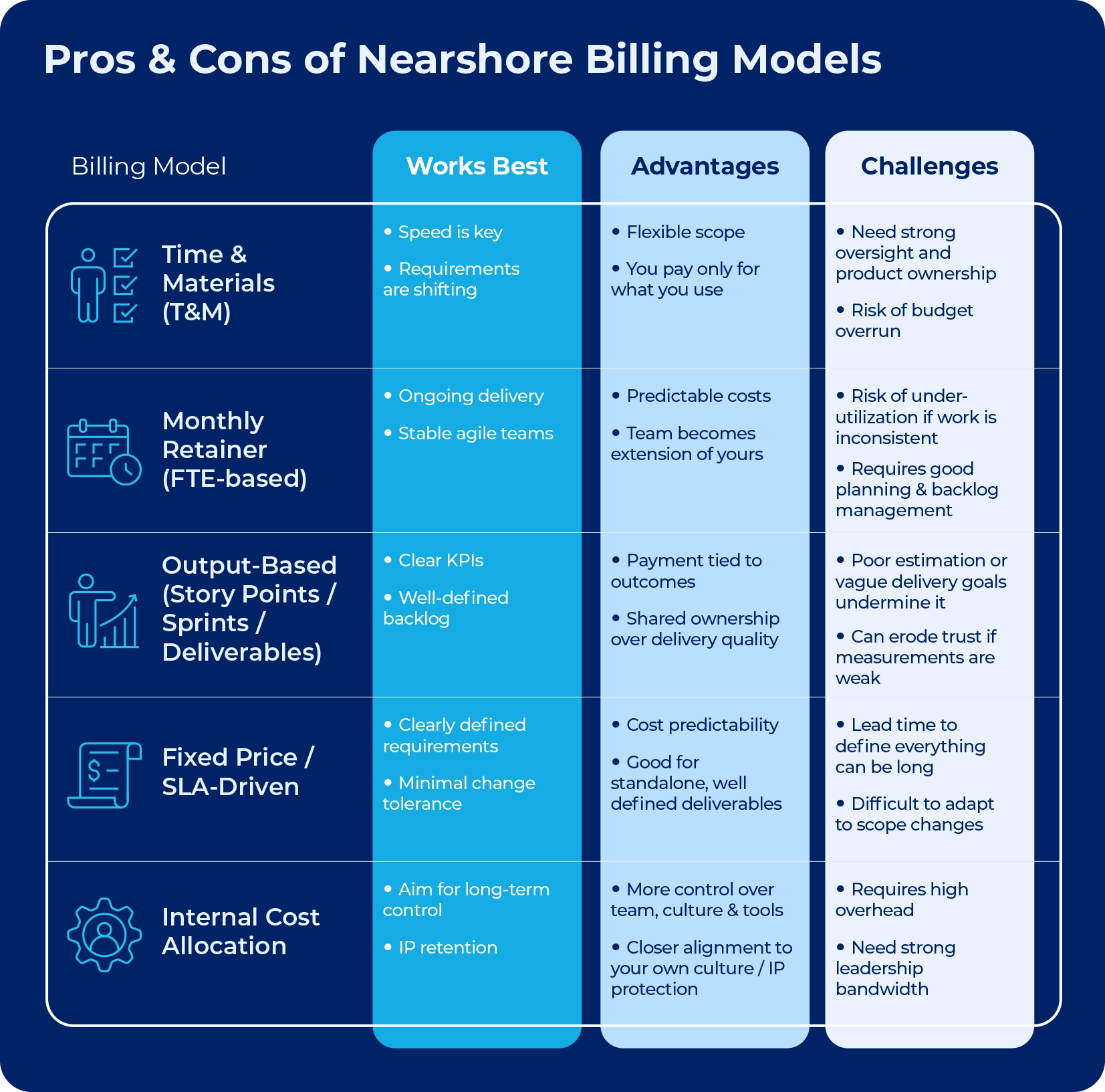Nearshoring is so much more than merely picking the right location or partner. As important as these are, it is also about choosing the right structure for how work gets done and paid for.

All too often, companies look no further than the hourly rate or vendor markup. However, the real differentiator is the billing model, as billing is not just a financial mechanism, but a genuine behavioral lever. It defines how your partner engages, what they take ownership of, how they prioritize, and ultimately, what outcomes you can expect.
Why Performance Matters More Than Price
Every billing model comes with trade-offs. Some give you flexibility but require hands-on oversight. Others guarantee fixed costs but limit you with rigid scopes. There are also models that look great on paper and are easy to sign off on until it becomes clear they will never truly align with your delivery rhythm.
The worst-case scenario? You choose a cheap rate and end up managing every Jira ticket manually, with little predictability and accountability.
So, what’s the best-case scenario?
You align your billing model with your team’s operating rhythm, delivery cadence, and strategic goals. That is when things start to click: velocity stabilizes, cost becomes predictable, and day-to-day delivery feels effortless.
When your billing approach mirrors how your teams work rather than just how your finance department wants to pay, you unlock something more than smooth procurement. You empower accountability, flow, and value at every level of your delivery ecosystem.
The Five Billing Models and When They Work
From Agile-ready retainers to rigid fixed-price contracts, each billing model brings its own logic, strengths, and risks. Let’s analyze the five most common approaches and when each one makes the most sense for your nearshore delivery strategy.

Time & Materials (T&M)
Starts fast, which is undoubtedly a huge advantage, but quickly becomes a grind as your team handles every task manually, with little rhythm or momentum. Indeed, when speed is everything and requirements shift on the fly, T&M might feel like the obvious choice.
However, with quick onboarding and scope flexibility comes much more responsibility. Unless the internal team can provide day-to-day direction and oversight, it is easy to burn budget and miss expected cost savings. Therefore, T&M only works well when you have strong in-house leadership, a detailed backlog, and the bandwidth to manage closely.
Unless the internal team can provide day-to-day direction and oversight, it is easy to burn budget
Monthly Retainer (FTE-based)
This model gives you stability, predictable costs, and a team that becomes an extension of your own, which is why it is ideal for companies with continuous delivery needs and Agile rhythms. However, its success depends on maintaining a steady flow of work, solid planning, and a clear integration into your delivery process. Without these, even an experienced team of high-quality software developers will inevitably end up underutilized.
Output-Based (Story Points, Sprints, Deliverables)
With this outcome-driven model, you are paying for progress rather than time. The model works best when you have a clear definition of KPIs, a mature Agile setup, and a well-groomed backlog. It shifts the focus to velocity and value and, when done right, encourages shared ownership and delivery quality.
Yet, the model can fall apart when estimation is found wanting or delivery concepts are vague. This means that a lack of measurement discipline can undermine its substantial benefits, lead to missed targets, and erode trust, even if you started with tailored pricing in mind.
Fixed Price / SLA-Driven
This is the go-to model for projects with tightly scoped requirements, minimal change tolerance, and a well-defined endpoint. It offers cost predictability and limited client effort during execution, but little to no flexibility. However, such contracts can be rigid, and even small tweaks in scope can trigger lengthy renegotiations or costly change requests.
This model works best for standalone, low-ambiguity projects with strict deadlines and a premium on budget control, especially when combined with tiered pricing to reflect phased deliverables and milestones.
Internal Cost Allocation (Captive Centers)
For companies committed to building in-house capabilities and full ownership of delivery, setting up a captive nearshore outsourcing unit can offer strategic advantages. It brings you closer to your own culture, accelerates IP retention, and allows complete control over the team and tooling.
This does come at a cost, though: the model demands serious commitment, as it is a high-effort path that puts you in charge of every operational detail. Running a captive center requires significant internal governance, legal and HR infrastructure, and mature operational processes.
Therefore, it only pays off when you’re in it for the long run, have the leadership bandwidth, and are prepared to invest in building an ecosystem rather than just hiring software developers.
Strategic Buyers Align Billing With Delivery – Not Just Budget
It is rather tempting to choose a billing model based on price or procurement policy. But if your team runs Agile sprints with daily standups, product owners, and CI/CD pipelines, then hourly billing will only slow you down. Likewise, if you lack internal delivery oversight or product leadership, output-based billing can become more of a burden than a benefit.
The takeaway? Success doesn’t come from matching a billing model to your finance process. It comes from matching it to your operating reality.
And that’s exactly what successful companies do differently:
- They treat billing as part of their delivery architecture, not just a procurement checkbox.
- They assess internal bandwidth, ownership, and readiness rather than just cost per hour.
- They avoid trying to “force-fit” Agile teams into rigid fixed-price contracts.
- They evolve their model over time, starting with retainers and growing into outcome-based models as maturity builds.
Scalefocus does things differently. We don’t just help clients set up Centers of Excellence, we design the right operating model around them, billing included, so they can scale fast, deliver with predictability, and drive cost-effective business outcomes.
Conclusion
It is easy to underestimate billing models, but the moment your team experiences velocity issues, knowledge gaps, or scope friction, you will realize how fundamental they are. When aligned with your operating style, the billing model empowers productivity and shared accountability. When misaligned, it erodes even the best-designed delivery setups.
Want to explore which model aligns with your strategy? Why don’t you contact us, we’ll happily have that conversation.



